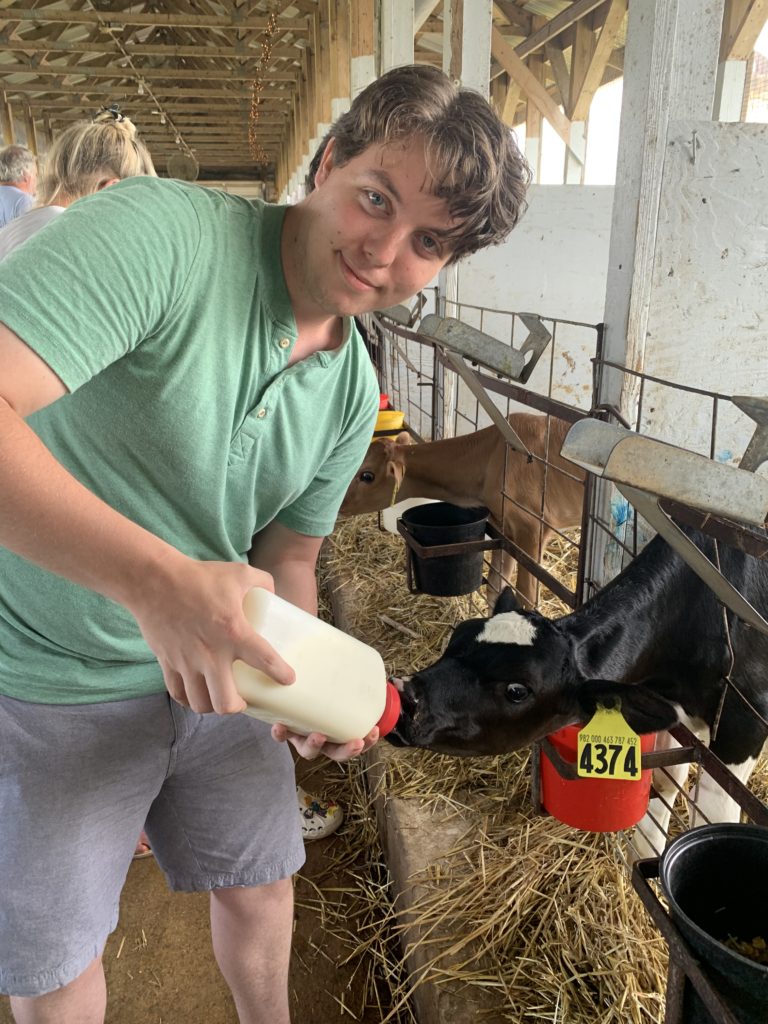A Visit to South Mountain Creamery

By Noah Hale
Now that Maryland’s Best Ice Cream Trail has sugar-coated the highways with promises of frozen delights, I thought I’d drive my taste buds across the state to one of these sweet spots and learn a thing or two about what goes on at a creamery.
South Mountain Creamery in Middletown is a beautiful slice of the countryside. Founded over 40 years ago by Randy and Karen Sowers, the dairy farm is situated in a scenic valley. On my way there, I could see some of the dairy cows grazing the hills that I’d later see being herded into their barns.
I met with my tour guides, Morgan Medlin and Lauren Harshman, who showed me around the entire farm. Our first stop was at the milking parlor.
Daily at 1:30 p.m., visitors can see the cows line up to be milked. First, their udders are sprayed with iodine for sterilization and then are attached to vacuum milkers that will do the milking much faster than a pair of hands can.
“They’re on a schedule,” said Morgan. “They know it’s milking time.” But they also look forward to milking time. The two primary types of cows, Holsteins and Jerseys, produce about 60 and 30 pounds of milk a day respectively—that means that each cow is losing 30 or 15 pounds during each milking. They’re eager to lose that extra weight.
Next, we walked over to a big metal reservoir—the milk tank—where the milk is brought after pumping. Once there, it goes through a cooling plate that cools it down to 55 degrees before returning to the milk tank, where it will cool down to 35 degrees.
“Milk comes out of the cow at 110 degrees, so we have to cool it down super fast so that it doesn’t curdle,” said Lauren. “And then it’s going to rest in this tank until our bottling team comes in the morning.”
Afterwards, all that’s left for the milk to do is to be pasteurized and homogenized, all of which is done in a nearby room. From there, the milk is used for ice-cream mix which is shipped to Chambersburg, Penn., where it gets turned into the final product.
While this was happening in the background, I was brought around the corner to see the two loafing barns where the cows can be lazy and enjoy the bovine comforts of air-conditioned back-scratching stations, rubberized mattresses, and all-you-can-eat hay. “It doesn’t smell the best, but it feels good,” said Lauren. She also told me they get to go out to pasture on the wide-open hillsides every evening.
It was quickly evident to me that the farmers take great care of all the cattle. They have an on-call veterinarian and a specialist who regularly inspects each pair of hooves. They even have a nutritionist who comes up with special diets for the cows depending on their needs. “We’re doing everything we can to make sure they’re as safe and happy and healthy as possible,” said Morgan.
Our last stop was at the calf barn where about 30 calves were waiting to be fed. This part of the farm is also open to the public and one of the creamery’s main attractions: at 4:00 p.m., visitors can purchase a ticket that’ll let them bottle-feed one of the hungry calves. I was assigned to one particularly cute Holstein calf that guzzled down every last drop of milk in under two minutes. When the bottle was empty she looked up at me as if to say, “Hey, where’s the rest?”
Like the heifers, the calves live a good life. They’re given warm blankets in the winter, a tarp that can be raised to keep out wind and rain or give them shade in the summer, and a dryer in their barn to dry them off in case they get wet. The farm is designed to be comfortable—for cows and people alike.
“We really like to educate people,” Lauren said. “Karen (Sowers) wanted to be able to have people come out to the farm and educate them on farming so they can see where their food comes from and why it’s done that way.”
When my tour was over I stopped at Karen’s Kountry Store to try some ice cream, where I was not disappointed. If you’re an ice cream lover or a calf adorer, make the trip up to South Mountain Creamery. There’s something for the whole family—and where else are you going to get to feed a baby cow?
